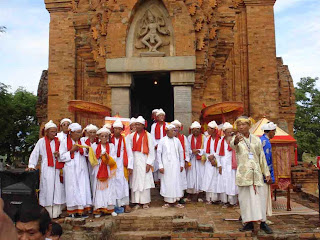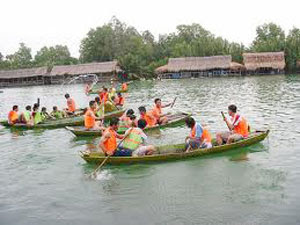Situated on the Northern bank of the Perfume River, with an area of 500 ha and a system of three circles of ramparts, namely from outside to inside: Kinh Thanh (Capital Citadel), Hoang Thanh (Royal Citadel) and Tu Cam Thanh (Forbidden Citadel).
Culture

Hue is one of the main cultural, religious and educational centers of Vietnam. So far, Hue remains to be the only originally historical vestiged city in Vietnam. Many of Hue’s attractions are found along the banks of the romantically named Perfume River with 11 km length. This valuable construction includes more than 100 architectural works, which are the reflection of the life of Emperors and mandarins under Nguyen’s reign.
Ar
chitecture in Hue is the combination of royal architect, folk, religious ones, traditional and modern sides. On the north bank of the river is the Imperial Citadel, built along the line of Peking’s Forbidden City, enclosed by 10-meter thick walls and surrounded by a moat. A few kilometers further up the river are perhaps Hue’s best-known religious site. Inside the citadel, there are still royal remnants such as the seat of the Nguyen emperors occupying a large, walled area on the north side of the river. Inside the citadel, it was a forbidden city where only the concubines, emperors, and those close enough to them were granted access, the punishment for trespassing was death penalty.
Situated in the middle of the hills on the Southern bank of Perfume River are very beautiful tombs of Nguyen Kings. Among these tombs are the four famous ones with the name and the arrangements of the tomb reflecting each Emperor’s points of view, personality, and tastes. This is majestic Gia Long tomb, imposing Minh Mang tomb, poetic Tu Duc tomb and magnificent Khai Dinh tomb. No architects who would like to discover ancient architecture of Vietnam could ignore Hue’s old citadel vestiges.
Citadel Complex of Hue
The Hue capital citadel started to be constructed in 1805 under the reign of Emperor Gia Long and was completed in 1832 under the sovereignty of Emperor Ming Mang. Over the past 200 years, it has still maintained original with nearly 140 small and large constructions.
With a square shape, it is almost 10 km in circumference, 6m high, 21m thick, with 10 entrances. On the top of the walls, 24 bastions are established for defensive purposes. Besides, the Citadel has an ancillary gate connecting the Tran Binh Bastion called the Tran Binh Mon (Peaceful protector Gate).
The Hoang Thanh (Royal citadel), also the most important part of the Citadel, which was built in 1804 but totally completed in 1833, under King Ming Mang’s reign.
The Citadel, which is more than 600m long for each side, was built with bricks of 4m high, and 1m thick. Around the citadel is a protecting trench system. Tourists can get access to the Imperial Citadel through four entrance gates. In the past, Ngo Mon Gate was only reserved for the King. Royal Citadel consists of more than 100 fascinating architectural works.
Passing through Hoang Thanh is the Tu Cam Thanh (Forbidden Citadel), which situated inside the Imperial Citadel complex, behind the Throne Palace, the Purple Forbidden Citadel was reserved for Emperor and his family.
Built in the early 1803 under reign of Emperor Gia Long, it was initially named Cung Thanh. In 1821, it was renamed into the today’s Tu Cam Thanh.
Religion
Hue is also an important center of Buddhism. In Hue and the surroundings still exists tens of pagodas constructed more than 300 years ago, and a hundred of temples and pagodas built in the early century. Thien Mu Pagoda with its distinctive seven-storey octagonal tower.
Thien Mu Pagoda (namely Heaven Fairy Lady Pagoda), also known as Linh Mu Pagoda, is one of the most fascinating and ancient pagoda in Hue city. It is situated on Ha Khe hill, on the north bank of the Perfume River, in Huong Long village, 5 kilometers from Hue city, which is easy to reach from the city center.
The beautiful pagoda was built in 1601. Later on, several kings of the Nguyen Dynasty such as Gia Long, Minh Mang, Thieu Tri and Thanh Thai, all had the pagoda restored.
The most striking feature of the pagoda, Phuoc Duyen tower (initially called Tu Nhan tower), was erected in 1884 by King Thieu Tri, and has become the unofficial symbol of Hue. This octagonal tower has seven storeys (2m high), which is dedicated to a Buddha who appeared in human form. It is the highest stupa in Vietnam, and is often the subject of folk rhymes about Hue, such is its iconic status and association with the city. More importantly, it is regarded as the unofficial symbol of the former imperial capital.
To the left of the tower is a pavilion sheltering an enormous bell, called Dai Hong Chung, and was cast in 1710 by Lord Nguyen Phuc Chu. It is famous for the great size, which is 2.5m high and 3,285 kg weigh. It is considered to be an outstanding achievement of 18th century bronze casting.
To
the right of the tower is a pavilion containing a stela dated from 1715. It is set on the back of a massive marble turtle, a symbol of longevity, and is 2.58 m high.
Royal Music
A lot
of foreign tourists are curious about Hue’s ritual royal music. Originated from eight kinds of ritual music under Le dynasty, under Nguyen dynasty, it has improved into 2 kinds of music: “Dai nhac” and “Nha nhac”, which are really magnificent, and skillful. Those are only played on formal occasions. This city is proud to be the cadral of traditional music. The Royal Refined Music was proclaimed by UNESCO as a Masterpiece of the Oral and Intangible Heritage of Humanity on December 1993.
(Source: VGP)
Should you are interested in witnessing Hue’s Citadel and explore other hidden corners of charming Hue , email Vietnam Jeep Tours at adventure@vietnamjeeptours.com or call +84 909620370.
---------------------------------
Related programs to Hue & around:
Full day discover the rural of Mekong Delta by Jeep
Biking to explore My Tho ( Mekong Delta)
Full day - Explore Mekong Delta by Motorbikes
2 days 1 night explore Rural Mekong Delta on Motorcycles
2 days 1 night pedal into the Heart of Mekong Delta
3 days 2 nights Bird- watching at Tram Chim National Park of Mekong Delta
3 days Deep into Mekong Delta ( Motorbike Tours)
5 Days Deep into Mekong Delta by Motorbike
5 Days Loop of Mekong Delta on bikes
6 days discover Mekong Delta and Phu Quoc island
 The average temperature all-year round in Mu Cang Chai is 18.5 Celsius
degrees. The mountain ranges are home to many different ethnic minority groups such
as the Mong ( 90% ), Thai ( 8%) , Kinh (
2% ). Every year, the H’Mong will flood the fields and prepare for the planting
seeds in April or May. Then they will wait four months until harvest-time. The
early or late harvest season depends on the weather. September and October are suggested
as the ideal time to visit Mu Cang Chai because this is advantageous time for
harvesting. In recent years, the authorities of Mu
Cang Chai have held some celebrations for marking the harvesting time in the
middle of September. This event attracts many photographers and travelers to Mu
Cang Chai.
The average temperature all-year round in Mu Cang Chai is 18.5 Celsius
degrees. The mountain ranges are home to many different ethnic minority groups such
as the Mong ( 90% ), Thai ( 8%) , Kinh (
2% ). Every year, the H’Mong will flood the fields and prepare for the planting
seeds in April or May. Then they will wait four months until harvest-time. The
early or late harvest season depends on the weather. September and October are suggested
as the ideal time to visit Mu Cang Chai because this is advantageous time for
harvesting. In recent years, the authorities of Mu
Cang Chai have held some celebrations for marking the harvesting time in the
middle of September. This event attracts many photographers and travelers to Mu
Cang Chai.
















